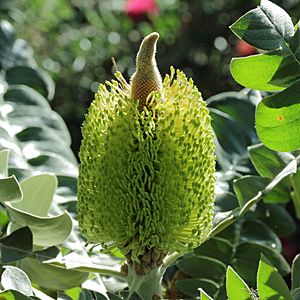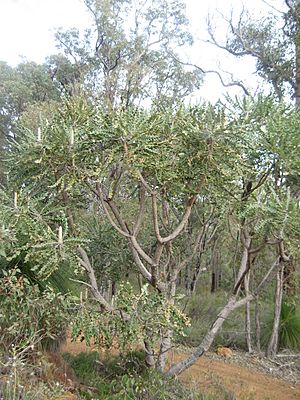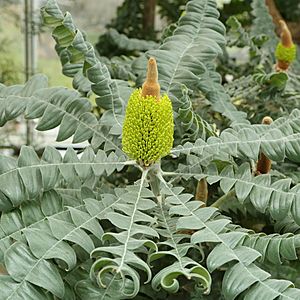Bull banksia facts for kids
Quick facts for kids Bull banksia |
|
|---|---|
 |
|
| Scientific classification | |
| Genus: |
Banksia
|
| Species: |
grandis
|
| Synonyms | |
|
Sermuellera grandis (Willd.) Kuntze |
|
The Banksia grandis, often called the bull banksia or giant banksia, is a common and unique tree. You can find it in the southwest part of Western Australia. The Noongar people, who are the traditional owners of this land, call the tree by names like beera, biara, boongura, gwangia, pira or peera. This tree has a strong main stem with thick bark that helps it survive fires. Its leaves have many triangular points, and its flowers are pale yellow. After flowering, it grows oval-shaped seed pods in a large cone.
Contents
What Does the Bull Banksia Look Like?
The Bull Banksia is usually a tree that grows about 5 to 10 meters (16 to 33 feet) tall. Sometimes, it can even reach 15 meters (49 feet). Near the south coast or among granite rocks, it might grow as a short, spreading bush. Its trunk is often short, thick, and a bit bent. It has rough, grey bark, which is common for banksia trees.
The leaves are quite large, from 10 to 45 centimeters (4 to 18 inches) long and 3 to 11 centimeters (1 to 4 inches) wide. They grow on a short stem about 1 to 3.5 centimeters (0.4 to 1.4 inches) long. Each leaf has eight to twelve large, triangular points on each side. The top of the leaves is shiny dark green, while the underside is soft and hairy.
The flowers grow in a long spike, which can be 10 to 40 centimeters (4 to 16 inches) long and 7 to 9 centimeters (3 to 3.5 inches) wide when it blooms. The flowers are pale yellow, and their styles (the part that receives pollen) are cream-colored. The flowers bloom from October to January. After flowering, the tree produces oval-shaped seed pods. These pods are about 1.7 to 2.5 centimeters (0.7 to 1 inch) long and grow on a very large cone. The old flowers usually fall off early, and the seed pods open as they get older.
How Did It Get Its Name?
The Bull Banksia, Banksia grandis, was first officially described in 1798. This was done by a scientist named Carl Ludwig Willdenow in his book Species Plantarum. The word grandis in its scientific name comes from Latin. It means "great," "large," or "tall," which perfectly describes this impressive tree.
Banksia grandis belongs to a group of banksias called Banksia series Grandes. This group only includes B. grandis and a close relative called B. solandri.
Where Does the Bull Banksia Grow?
The Bull Banksia grows in woodlands and open areas with low shrubs, known as heathlands. You can find it along the coast between Mount Lesueur and Cape Leeuwin. It also grows further east to Cape Riche and inland to Woodanilling. It is very common in the jarrah forest, which is found on the Darling Range.
Animals That Interact with the Bull Banksia
Many animals visit the Bull Banksia. Birds that eat nectar, like the Anthochaera carunculata (red wattlebird), have been seen feeding on its flowers. The Purpureicephalus spurius (red-capped parrot) also eats the seeds. Black cockatoos, including Calyptorhynchus baudinii (Baudin's black cockatoo) and C. latirostris (Carnaby's black cockatoo), have also been seen eating its seeds.
How People Use the Bull Banksia
Growing Bull Banksia in Gardens
The Bull Banksia is not grown in gardens very often. It grows quite slowly, taking ten years or more to produce flowers from a seed. It is also very sensitive to a plant disease called dieback. This makes it hard to grow in places with humid summers. It needs sandy soil that drains water well. The seeds do not need any special treatment to grow. They usually sprout in about 22 to 42 days.
Traditional Uses by Indigenous People
The flowers of Banksia grandis were very important to the Indigenous peoples who live where the tree grows. They called the flowers mangyt, pulgarla, or Bool gal la. They would soak the flowers in water or suck on them directly to get the sweet nectar inside.
Taylor, Anne; Hopper, Stephen (1988). The Banksia Atlas (Australian Flora and Fauna Series Number 8). Canberra: Australian Government Publishing Service. ISBN 0-644-07124-9.
See also
 In Spanish: Banksia toro para niños
In Spanish: Banksia toro para niños




